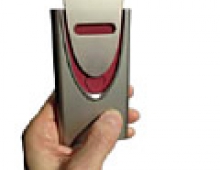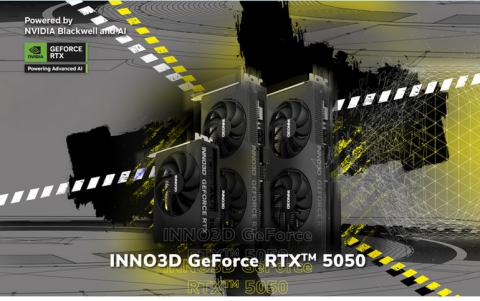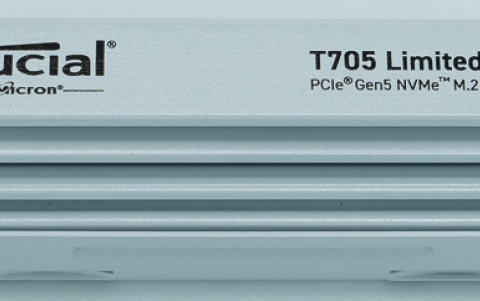
Hitachi's DVD Video camera about same size as DV Video recorder
Hitachi Ltd plans to debut in March 2003 a home DVD video camera, the "DZ-MV350," which records video to a writable DVD, and has dimensions as small as 57mm x 89mm x 134mm. The company reduced the size by 50% in volume and 30% in weight compared to the previous model that was released in 2002. "The size is the same, if not smaller, than most DV video camera recorders on the market. As the dimensions have drawn level, the DVD's strength of easy video editing and fast rewinding and forwarding will now be utilized more than before," said Hitachi.
DVD-RAM and DVD-R with diameters of 8cm are used as the recording media. A 1/4-inch CCD solid-state, image-sensing device with 680,000 pixels is adopted. The weight, with secondary batteries loaded, is 565g. It is equipped with an SD Memory-card slot, with which still pictures can also be stored. The price is open and the market price is expected to be around 120,000 yen. (118.75 yen = US$1)
Furthermore, the higher end model "DZ-MV380," which has a 1/3.8-inch CCD solid-state, image-sensing device with 1,020,000 pixels, will be also available in May 2003. The market price is expected to be around 140,000 yen.
With the realization of competitive dimensions with DV systems, Hitachi foresees rapid progress in a shift of consumers to DVD video cameras from DV video recorders.
According to a calculation by the company, in 2005 the annual shipment of DVD video cameras in Japan will be 860,000 units, which will occupy more than half of all the video cameras, whereas it was 20,000 units in 2002.
"Compared to a tape, DVD-RAM and DVD-R discs are considerably easier when it comes to special playbacks and video editing. Furthermore, with the circulation of DVD players and DVD recorders, the environment for playing video at home is becoming conventional. Under these circumstances, the DVD video camera market would develop rapidly. Incidentally, the shift from VHS to DV advanced rapidly within about three years in the middle of the 1990's in Japan. A shift from DV to DVD disc will advance in a similar manner," said Hitachi.
This time, there are three main reasons Hitachi achieved substantial size reductions.
First, a round cartridge is adopted instead of the conventional square-shape disc cartridge. This cartridge was jointly proposed by three companies: Hitachi, Hitachi Maxell Ltd and Matsushita Electric Industrial Co, Ltd, and standardized at the DVD Forum. Adopting the round cartridge with no angles, which is similar to a disc in size, brought a greater flexibility in reducing the dimensions of DVD drives. The diameter of the drive is 75.0mm, which is almost 1.5mm shorter than that of the previous model of 91.1mm.
Second, the thickness of DVD drive is also reduced to 8.7mm. By and large, this is achieved as a result of the substrates mounted with a servo circuit, etc., being reduced in size. Smaller substrates enabled a displacement of substrates, which would otherwise be covering the bottom surface of the drive. "Substrates becoming smaller contributed the most in making the drive smaller," said Hitachi. In addition, it aims at adopting a thin spindle motor by making alterations to the structure of the positioning mechanism of an optical pickup.
And third, the number of substrates is reduced to two, from the conventional number of three, and thereby it achieved reduction of the thickness by 9mm from the conventional one. The mounting dimension is reduced by integrating the peripheral circuitry, such as image-processing LSIs for MPEG-2 and JPEG, audio LSIs, etc., using the multi-chip module technology.
"in the future, like in Mini Disc, it may be possible to reduce the size of a DVD drive to a jacket size. Without a doubt, as far as thinness is concerned in particular, it is easier to make the size smaller than the DV system," the company said, implying a further reduction of the size.
Furthermore, the higher end model "DZ-MV380," which has a 1/3.8-inch CCD solid-state, image-sensing device with 1,020,000 pixels, will be also available in May 2003. The market price is expected to be around 140,000 yen.
With the realization of competitive dimensions with DV systems, Hitachi foresees rapid progress in a shift of consumers to DVD video cameras from DV video recorders.
According to a calculation by the company, in 2005 the annual shipment of DVD video cameras in Japan will be 860,000 units, which will occupy more than half of all the video cameras, whereas it was 20,000 units in 2002.
"Compared to a tape, DVD-RAM and DVD-R discs are considerably easier when it comes to special playbacks and video editing. Furthermore, with the circulation of DVD players and DVD recorders, the environment for playing video at home is becoming conventional. Under these circumstances, the DVD video camera market would develop rapidly. Incidentally, the shift from VHS to DV advanced rapidly within about three years in the middle of the 1990's in Japan. A shift from DV to DVD disc will advance in a similar manner," said Hitachi.
This time, there are three main reasons Hitachi achieved substantial size reductions.
First, a round cartridge is adopted instead of the conventional square-shape disc cartridge. This cartridge was jointly proposed by three companies: Hitachi, Hitachi Maxell Ltd and Matsushita Electric Industrial Co, Ltd, and standardized at the DVD Forum. Adopting the round cartridge with no angles, which is similar to a disc in size, brought a greater flexibility in reducing the dimensions of DVD drives. The diameter of the drive is 75.0mm, which is almost 1.5mm shorter than that of the previous model of 91.1mm.
Second, the thickness of DVD drive is also reduced to 8.7mm. By and large, this is achieved as a result of the substrates mounted with a servo circuit, etc., being reduced in size. Smaller substrates enabled a displacement of substrates, which would otherwise be covering the bottom surface of the drive. "Substrates becoming smaller contributed the most in making the drive smaller," said Hitachi. In addition, it aims at adopting a thin spindle motor by making alterations to the structure of the positioning mechanism of an optical pickup.
And third, the number of substrates is reduced to two, from the conventional number of three, and thereby it achieved reduction of the thickness by 9mm from the conventional one. The mounting dimension is reduced by integrating the peripheral circuitry, such as image-processing LSIs for MPEG-2 and JPEG, audio LSIs, etc., using the multi-chip module technology.
"in the future, like in Mini Disc, it may be possible to reduce the size of a DVD drive to a jacket size. Without a doubt, as far as thinness is concerned in particular, it is easier to make the size smaller than the DV system," the company said, implying a further reduction of the size.





















